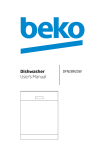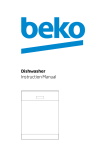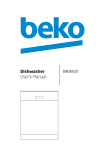Download User`s Manual
Transcript
Dishwasher User’s Manual DFN2000X Welcome Dear customer Congratulations on your choice of a Beko quality dishwasher which has been designed to give you lasting service. Please read these instructions before installing the dishwasher and using it for the first time. The information contained herein is provided to avoid accidental risks and/or damage to your appliance Make sure you understand the controls prior to using your appliance. The dishwasher must only be used for it’s intended purpose, i.e. the washing of dishes in the home. Failure to observe these instructions may invalidate your right to free service during the guarantee period. Please keep these instructions in a safe place for your future reference If you have any questions, or if you are not sure about any information contained in this booklet please contact us - details are on the back cover. Beko Customer Service Notes Due to the quality control processes during production, there may be some water left in your machine. This does not cause any damage. Preparation before use It is recommended that the dishwasher is operated on the Eco programme with prewash before loading with dishes. Dishwasher User’s Manual DFN2000X Welcome Dear customer Congratulations on your choice of a Beko quality dishwasher which has been designed to give you lasting service. Please read these instructions before installing the dishwasher and using it for the first time. The information contained herein is provided to avoid accidental risks and/or damage to your appliance Make sure you understand the controls prior to using your appliance. The dishwasher must only be used for it’s intended purpose, i.e. the washing of dishes in the home. Failure to observe these instructions may invalidate your right to free service during the guarantee period. Please keep these instructions in a safe place for your future reference If you have any questions, or if you are not sure about any information contained in this booklet please contact us - details are on the back cover. Beko Customer Service Notes Due to the quality control processes during production, there may be some water left in your machine. This does not cause any damage. Preparation before use It is recommended that the dishwasher is operated on the Eco programme with prewash before loading with dishes. TABLE OF CONTENTS Canceling a programme 23 1 Know your dishwasher Programme Step Follow-up 23 / specification 3 Warning Messages 25 2 Warning and safety information5 8 How to clean your dishwasher27 Electrical Safety 5 Stainless steel door cleaning Children’s Safety 5 instructions 27 General5 Upper spray arm 28 Recycling6 Lower spray arm 28 What should not be washed in your dishwasher6 9 Before calling service 29 3 Before first use 7 / Trouble shooting Turbo fan heat drying system 7 4 Installation 7 Electrical requirements 8 Warning 8 This appliance must be earthed 8 Important8 Fitting a different plug 8 Water inlet hose connection 9 Drain Hose Connection 10 5 How to use 13 Rinse aid 14 Filling the Detergent Dispenser 15 Detergent15 Multipurpose Detergents 15 Loading the dishwasher 17 Folding plate support rods 18 Bottle holder 18 Movable Cutlery Basket 18 Upper basket with variable height setting19 Folding Tines 19 6 Starting Your Machine 20 Language Selection 20 Programme selection 21 Key Lock 22 Stopping the machine 22 1 Know your dishwasher / specification Removable work top Top Spray Turbo Fan Heat Drying System Upper spray arm Upper basket Upper basket track latch Heating element concealed behind the liner Lower spray arm Dishwasher salt cap Lower basket Cutlery basket Filters Detergent and Rinse aid dispenser Removable kick plate Salt Level Indicator Light Rinse Aid Level Indicator Light Start / Pause / Cancel Button LCD Display 3 GB Specification Load Capacity Height Width Depth Depth/Height (without worktop) Net weight Supply voltage Fuse currrent Total power Heater power Pump powers Diameter of plates for : Upper basket Lower basket : 12 Place settings : 850 mm : 598 mm : 598 mm : 570 mm / 820 mm : 45 kg : 220-240 V ~ 50 Hz : 10 A : 1800-2100 W : 2000 W : 90/30 W : 25 cm max. : 31 cm max. Because we continually strive to improve our products, we may change our specifications and designs without prior notice. Note for Testing Institutes The necessary information for performance testing will be provided upon request. The request can be done by e-mail through: [email protected] Please do not forget to write the model code ,stock code and serial number information of the appliance besides your contact information in the e-mail. The model code, stock code and serial number information can be found on the rating label, which is placed on the side of the door. 4 GB 2 Warning and safety information Electrical Safety The dishwasher should only be operated on the voltage specified. For electrical safety, only earthed plugs and sockets should be used. Always use the fused plug provided with the appliance. The user is responsible for meeting these basic safety requirements. The life of your machine and your safety depend on you using an electrical installation compliant to standards. Do not use an extension cable. When disconnecting your machine from the mains supply, always pull from the plug. Never pull the cord itself. Children’s Safety Never allow your children to play with your dishwasher. Dishwasher detergents contain irritants and abrasives. These ingredients might have caustic effects in the eyes, mouth and throat. They can be extremely dangerous if swallowed. Avoid contact with skin and eyes. Check that the detergent receptacle is empty after completion of the wash cycle. Keep detergents out of children’s reach and do not put detergent in the machine until right before you start the washing programme. The water in your dishwasher is not suitable for drinking, for this reason do not allow your children near your machine when the front door is open. Never allow your children to play on or sit onto the front door when the front door is open. After unpacking your machine, keep the packing material out of children’s reach. Warning ! Long cutlery, such as ladles and long knives, etc must be placed horizontally on top of the full cutlery basket or on the racks to prevent accidental injury. General This dishwasher has been designed to clean your dirty dishes at home. Never use chemical solvents in your machine; this may lead to explosion risk. Never use materials other than specially produced softening salts in the salt dispenser of your machine. Never use materials other than specially produced detergents and rinse-aids in the detergent and rinse aid dispensers of your machine. Please dispose of the packaging material and old appliances carefully. Please ensure old machines do not become a threat to child safety. It is known that children lock themselves in unused machines. To avoid such a problem it is advised that you cut the mains cable off and break the door latch so it does not lock. The door of your machine is designed to support the weight of a full basket when the lower basket is pulled all the 5 GB What should not be washed in your dishwasher way out. Never place any other load on the door, otherwise the machine may tip over. Do not wash items soiled with cigarette ash, candle, paint wax, dyes, chemicals etc. since these may damage your machine After using the dishwasher always close the door as an open door can be a hazard. Do not open the door whilst the appliance is in operation. Recycling Please help us to protect our environment. Packing materials and some parts of your machine are produced using recyclable materials. These materials are marked up with recycling symbol and material type information (>PE<, >PS<, >POM< …). These raw materials should not be mixed with general refuse and should be given to recycling centers. We suggest you contact your local authority for disposal information and facilities available. This product bears the selective sorting symbol for waste electrical and electronic equipment (WEEE). This means that this product must be handled pursuant to European Directive 2002/96/EC in order to be recycled or dismantled to minimize its impact on the environment. For further information, please contact your local or regional authorities. Do not wash forks, knives and spoons with wooden or bone handles, items stuck together with adhesives, plastic items not resistant to high temperatures. Copper, tin items and aluminium ware in your dishwasher. As with hand washing, some “onglaze” decorated china, aluminum or silver have a tendency to discolour or fade. Also, certain types of glassware and crystals may lose their shine and become opaque in time. A chemical reaction can occur between silver cutlery and stainless steel cutlery. As a precaution, do not wash together. Iron and cast iron objects can rust and stain other items. Pay special attention to whether or not the item you wash in the dishwasher is dishwasher-proof. If in doubt, contact the manufacturer of the item. Do not overload your dishwasher or do not load items other than those mentioned in this manual. Electronic products not included in the selective sorting process are potentially dangerous for the environment and human health due to the presence of hazardous substances. 6 GB 3 Before first use After unpacking your dishwasher, check the machine against any possible transportation damage. Never install and use damaged machines. If your machine is damaged contact your retailer. Always have your machine installed by qualified electrician/plumber to ensure correct installation. Any repairs and maintenance work on this dishwasher should be carried out by authorised service staff only. Unauthorised repairs are not only dangerous, but also lead to the cancellation of your warranty. If your dishwasher has an Internal Lighting; incase of a defect broken lamps can be changed by an authorized service technican. Make sure the electricity and water connections of your dishwasher are in compliance with the instructions for assembly as stated in the relevant part of this booklet. It is recommended that the dishwasher is operated without dishes for very first wash for hygiene reasons. Before the first wash, add 1 lt of water to the salt container of your machine. Turbo fan heat drying system Turbo Fan Heat Drying System ensures your dishes are dried efficiently. ! During operation you may hear fan noise which is normal. 4 Installation When deciding on where to install your new dishwasher, ensure that the position of your dishwasher makes it easy and quick for you to place the dishes in the dishwasher and also to take them out and store away after the dishwashing is completed. Avoid placing the dishwasher where the ambient temperature is likely to fall below. 5 degrees C. (41° F) When positioning your appliance, take care not to damage your flooring, pipes wall coverings etc. Do not move the appliance by pulling by the door or handle 7 GB Electrical requirements Important Fitting a different plug Before you insert the plug into the wall socket make sure that the voltage and the frequency shown in the rating label corresponds to your electricity supply. As the colours of the wires in the mains lead of this appliance may not correspond with the coloured markings identifying the terminals on your plug, proceed as follows: We recommend that this appliance be connected to the mains supply via a suitable switched and fused socket in a readily accessible position. 1. Connect the green - yellow or green (earth) wire to the terminal in the plug marked ‘E’ or with the symbol or coloured green and yellow or green. If the supply cord or the mains lead is damaged please do not replace it yourself. The supply cord or the mains lead must be replaced by a Beko Authorised Service Agent or a similarly qualified person. Warning This appliance must be earthed 2. Connect the blue (neutral) wire to the terminal in the plug marked ‘N’ or coloured black. 3. Connect the brown (live) wire to the terminal in the plug marked ‘L’ or coloured red. If the fitted moulded plug is not suitable for your socket, then the plug should be cut off and an appropriate plug fitted. Destroy the old plug, which is cut off as a plug with a bared cord could cause a shock hazard if inserted into a socket elsewhere in the house. The moulded plug on this appliance incorporates a 13A fuse. Should the fuse need to be replaced an ASTA approved BS1362 fuse of the same rating must be used. Do not forget to refit the fuse cover. In the event of losing the fuse cover, the plug must not be used until a replacement fuse cover has been fitted. Colour of the replacement fuse cover must be the same colour as that visible on the pin face of the plug. Fuse covers are available from any good electrical store. With the alternative plugs a 13A fuse must be fitted either in the plug or adaptor or in the main fuse box. If in doubt contact a qualified electrician. 8 GB Water inlet hose connection Make sure your plumbing is suitable to install your new dishwasher. If in doubt contact a qualified plumber. The appliance must be connected to the water mains using the new hose set supplied with your new dishwasher. Old hose sets must not be re-used. The water pressure coming from the water mains supply must be a minimum of 0.3 and a maximum of 10 bars. Connect the straight end to your water mains supply 1 Ensure plastic filter and black rubber seal is in place. Please turn on the tap and check for leakages after connecting the hose. We recommend the tap is turned off when the machine is not being used. If you only have one cold water feed (For example for your washing machine) don’t worry, a Y adaptor will provide you with the additional cold water feed you need for your dishwasher. Y adaptor is available from most DIY stores. AQUASAFE+ The Aquasafe+ System protects against water damage which may be caused at the water inlet hose. Do not immerse the system’s valve box into water; it contains electrical components. In case of damage, pull out the power supply plug. Do not shorten or lengthen the hose insert as it contains electrical cables and components. 9 GB Drain Hose Connection Fit the drainage hose of your machine to the drainage pipe without bending. Secure your hose firmly to the waste pipe to avoid it coming off during the washing process. The waste pipe must only be connected into the foul drains and not surface water drainage system. The hose should be placed between 50 cm and 110 cm from the floor level and must not be extended otherwise the machine may not empty the waste water. 10 GB Installation of dishwasher Remove all packaging before positioning the machine. See the following diagram. Ensure there is a clearance each side of the machine to allow slight side ways movement for servicing. Note: If there is already enough space, you don’t need to remove the worktop to install it under the counter. Position the machine next to a water tap and a drain. When inserting the machine, ensure that the water inlet and drain hoses are not linked or squashed. 11 GB Care must be taken to ensure that the appliance does not stand on the electrical supply cable. Good levelling is essential for correct closure and sealing of the door. Make sure your dishwasher is perfectly level using the adjustable feet. When the appliance is correctly levelled, the door will not catch on the inner liner on either side of the cabinet. If the door does not close correctly, loosen or tighten the adjustable feet, until the machine is perfectly level. 12 GB 5 How to use Adding Dishwasher Salt Only use special pelletized dishwasher salt in your machine to soften the hard water. Never use other types of salts including table salt, animal feeding salt, sea salt, culinary salt. These types of salt do not dissolve in water easily and will damage your appliance beyond repair. clockwise until you hear a click sound. In case the light of the salt indicator is still on for a long time after filling with salt, mix the salty water inside the salt box using a spoon. To fill the container with softening salt, remove the lower rack first and unscrew the cap of the water softener turning anti clockwise. Using the funnel provided will make filling easier. After you fill the container, screw cap tightly back into place turning 13 GB Caution: Only fill with salt just before starting one of the complete washing programmes to prevent any grains of salt causing corrosion. Ensure 1lt of water has been added. You can put approximately 2 kg softening salt in the Water softener. When you run the dishwasher, the Water softener will be full of water. Therefore, adding softening salt should always be done immediately before you start the dishwasher. Rinse aid Filling the rinse aid dispenser Open the rinse aid dispenser lid by pressing the button as shown in the diagram. Fill up with rinse aid until the container is full to level of ’max’ mark . Put the lid (E) on and ensure you hear the clicking sound. Remember to CLOSE the lid after every refill. Make sure you clean any rinse aid that you might have spilled. Use only rinse aid intended for household dishwashers. The rinse aid is specially formulated to be used in the dishwashers for the prevention of watermarks and scale on dishes and to increase the efficiency of the washing and drying processes. Therefore, make sure that there is adequate amount of rinse aid in the rinse aid dispenser of your machine. You can adjust the amount of rinse aid used during the wash programme by turning the rinse aid dispenser regulator (C). The dispenser regulator (C) may be set between levels 1 and 6 (6 being the maximum amount of rinse aid usage). Your machine is pre-set at the factory to level 4. According to the finish and drying results obtained, adjust the dose of rinse aid by means of the six position selector. (Position 1: minimum dose, Position 6: maximum dose.) Gradually increase the dose if there are drops of water or lime spots on the dishes after washing. Reduce it if there are sticky whitish streaks on the dishes. 14 GB Filling the Detergent Dispenser When the dishes are less dirty, it is generally sufficient to fill the detergent up to the 15 cm³ mark. If you are using tablet detergent one tablet is enough. Open the detergent container by pushing the locking lever to the right (A). Important Put the detergent into the detergent dispenser and make sure lid is closed firmly. Note Only use detergents formulated for use in dishwashers. Detergent Please use detergents produced specially for the dishwashers in your machine. Keep the opened detergent packages in a cool and dry place where children can not reach. Put the detergent into the detergent dispenser just before operating the machine. Please contact the manufacturer to get detailed information about the detergent you are using. Excessive usage of powder detergents can cause the detergent not dissolve completely and can also cause scratches on the glassware. The lines on the inside of the detergent container will help you measure the correct amount of detergent. Multipurpose Detergents The detergent container holds a total of 40 cm³ of detergent (1). When the dishwasher is fully loaded and the dishes are very dirty, we recommend filling the detergent container up to the 25 cm³ mark. The best washing results in dishwashers is obtained by using detergent, rinse aid and water softening salt individually. New products of the detergent producers what they call as “Multipurpose Detergent” can act as 15 GB water softening salt and/or rinse aid in addition to acting as a detergent. Some types of these detergents can also contain special-purpose washing chemicals such as glass and stainless steel protectors. Multipurpose detergents commonly found in the market: 2in1: Those contain detergent, rinse aid or water softening salt. 3in1: Those contain detergent, rinse aid and water softening salt. 4in1: Those containing glass protectors in addition to detergent, rinse aid and water softening salt. 5in1: Those containing glass and stainless steel protectors in addition to detergent, rinse aid and water softening salt. Multipurpose detergents give satisfying results only under certain usage conditions. Observe the instructions of the detergent manufacturer on the package when using such detergents. Contact the detergent producer if your dishes are wet and/or if you notice lime spots particularly on your glasses after the washing programme is over. When you give up using such detergents: Make sure that salt and rinse aid compartments are full. Make the appropriate rinse aid settings. 16 GB Loading the dishwasher Loading the dishwasher correctly will increase the washing, drying and energy performance of your machine. Examine the information given in this section and the information stated in the Programme chart and quick reference card given with the manual. Remove any large scraps of food from the dishes before placing in the dishwasher to avoid clogging the filters. There are three separate baskets, in which you can put your dishes. Place large or heavily soiled items in the lower basket, and small, light or delicate articles in the upper basket. Put forks, small and medium size knives and spoons in the cutlery basket. Place tall, narrow items in the middle of the racks. Long-stemmed glasses should lean against the basket, the racks, or the supports not against the dishes. The shelves on the rack are made height adjustable to accommodate tall items. When loading your dishwasher please ensure tall glasses (and/or wine glasses) rest against the sides of the upper basket. Do not allow tall glasses to rest against each other since they may be damaged during washing if not properly supported. Always arrange saucepans, cups and glasses etc. upside down. You can fold the racks in the upper basket when you need more space for larger items. 17 GB Folding plate support rods There are four separate “folding plate support rods” in the lower basket of your dishwasher designed to allow you more space to accommodate saucepans and large bowls in the lower basket. You can either fold each section (1,2,3,4) individually or, all at once, to create a large empty space. Simply press the handgrips (A) and fold them down” Movable Cutlery Basket Designed to allow free placement of the dishes according to their size, the movable cutlery basket can slide over the tines to the left (A) and right (B) side. Bottle holder For cleaning your bottles. To remove, pull the holders apart in opposite directions (H). 18 GB Upper basket with variable height setting The upper basket is equipped with a lifting mechanism which enables you to change the height of the basket without having to remove it from the dishwasher, even if it is fully loaded. The height of the upper basket was set to its lowest position at the factory. To lift the upper basket to the “high” (A) position, hold it on one side and carefully pull it upwards. To lift the opposite side of the basket, hold it and pull it upwards in the same manner (A). To lower the upper rack, hold and press in the rack lever on one side and carefully lower the rack without releasing the lever (B). Repeat the procedure with the lever on the opposite side of the basket. Make sure that both levers catch at the same height. Folding Tines There are “folding tines” in the upper rack to allow you more space to accommodate glasses or cups. Simply pull in the first front folding tine, move it to left (A) and right (B) to place in another positon. When you need, take the tines down until the tines fall down. 19 GB 6 Starting Your Machine 1. On/Off Button It is used to power on the machine. Language Selection 2. Salt Indicator It is used to indicate that the salt in the salt container has depleted. Refill the salt container with salt again when the indicator lights up (See. Adding Salt). • 3. Rinse Aid Indicator It is used to indicate that the rinse aid in the rinse aid container has depleted. If you want to use rinse aid, refill the rinse aid container with rinse aid again when the indicator lights up (See. Adding Rinse Aid). • 4. Start/Pause/Cancel Button It is used to startup, pause or cancel the programme. 5. Display It shows the programme steps, time remaining to the end of the programme and warning messages. • • • • • 20 GB Press the On/Off button to turn on your machine when its door is open. Then, press the Start/Stop button for 10 secs. “Settings” will be displayed and countdown will start from 10 secs. You will enter in the “Settings” menu at the end of the countdown and the language selection menu “Language” will be displayed. The default language will be shown on the machine after you have pressed and held the Start/ Stop button for 5 secs. Proceed by pressing the Start/ Stop button to see the other languages. Press and hold the Start/Stop button for 5 secs when the language you would like to select appears on the screen. “Saved” will be displayed. Turn off the machine by pressing the On/Off button to exit the language selection menu. • Turn on your machine by pressing the On/Off button to return to the washing display. NOTE: The key lock will not be activated when the door is open and programme cancellation will not be possible. • Starting Your Machine • Open the tap. • Plug the mains plug into the wall socket. • Open the door. • Press On/Off button. • Check if the salt and rinse aid indicators light and add salt and/ or rinse aid if needed. • Place the dishes. • Check if the upper and lower impellers rotate freely. • Put sufficient amount of detergent in the detergent dispenser and close its lid. • Start the programme by pressing Start/Pause/Cancel button. WARNING: Pay attention not to open the door of the machine when it is running. Stop the machine by pressing Start/Pause/ Cancel button if you have to open the door. Then, open the door. There may be a rush of vapor when you open the door of your machine. Be careful. Close the door and press Start/Pause/ Cancel button again. Programme will resume running. • • Key lock will be activated 30 seconds after the programme starts and ”Key Lock Activated” will be displayed. Energy saving system will be activated 90 seconds after the • • • • programme starts and the display is dimmed. If you touch the button again, display brightness returns to its original status. “End” will be displayed when the programme is over. The amount of water and energy consumed will be displayed consecutively. Press the On/Off button to turn off your machine when the programme is over. Close the tap. Unplug the mains plug from the wall socket. Leave your dishes in the machine for about 15 minutes after they are washed in order to have them cooled down. Your dishes will dry in a shorter time if you leave the door of your machine ajar during this period. This will increase the drying effectiveness of your machine. Programme selection You will be prompted to select ECO or AUTO programme when you press “Start / Pause / Cancel” button while the “Press to wash” message is being displayed. When you see the “Press to wash” message, press “Start / Pause / Cancel” button. Messages that countdown for AUTO programme will be displayed: Press for AUTO 5 Press for AUTO 4 Press for AUTO 3 Press for AUTO 2 Press for AUTO 1 If no process is done at the end of the countdown, “ECO programme selected” message will appear and washing will start. 21 GB If you want your machine to wash in AUTO programme, press “Start / Pause / Cancel” button during countdown. “Press to wash” message is displayed. When you press the “Start / Pause / Cancel” button again “AUTO programme selected” message will appear and washing will start. be displayed. If you press the button when the key lock is active, “Key Lock Active” is displayed and if you press the key for a second time, “Press for 5 sec” is displayed. You must press Start/ Pause/Cancel key until the “Key Lock Deactivated” message is displayed to deactivate the key lock. Key Lock When you keep the Start/Pause/ Cancel key pressed, the countdown of 5 seconds starts and the following messages are displayed consecutively: Your machine is equipped with a key lock function in order to avoid anyone else but you, particularly the children, to interfere with and change the programme flow while the machine is operating. Key lock also functions as a safety system that prevents you from performing accidental operations by pressing a button unintentionally when you want to add or take out dishes from the machine. Key lock is activated automatically in the following conditions: • 30 seconds after the machine is turned on by pressing the On/ Off button and the programme is started • If the programme does not start within 30 seconds after the machine is turned on by pressing the On/Off button • If you wait more than 30 seconds when the machine is stopped during washing Key lock is deactivated automatically when the programme is over: If you press the touch-key at the end of the programme, machine will display the “Press to wash” message. If the machine is left to wait in this status, key lock will be activated after 30 seconds and “Key Lock Activated” will “Unlock the keylock 5” “Unlock the keylock 4” “Unlock the keylock 3” “Unlock the keylock 2” “Unlock the keylock 1” “Keylock deactivated” Key will remain locked if you release the key before the “Keylock deactivated” is displayed. Key lock is deactivated when the “Keylock deactivated” message is displayed. You can press the Start/Pause/Cancel key to perform the operation you want after the key lock is deactivated. Stopping the machine Deactivate the key lock first if you want to add/take out dishes to/from the machine before determining the level of washing. Then, you can stop the washing by pressing the Start/ Pause/Cancel key again. In this, case, following messages will displayed consecutively: “Paused” “Press to continue” 22 GB Press the Start/Pause/Cancel button again to deactivate the key lock and resume the programme if the key lock is activated after you have completed your operation. Canceling a programme WARNING: There might be residues of detergent or rinse aid in the machine and/or on the pieces already washed depending on the step the cancelled programme was in at the end of such cancellation. You need to perform a canceling operation if you want to end a programme before it is over. To cancel a programme: Programme Step Follow-up Deactivate the key lock if it is active. “Paused” is displayed if you press the Start/Pause/Cancel key when the key lock is deactivated. If you continue to keeping the Start/Pause/Cancel key pressed, the countdown of 5 seconds starts and the following messages are displayed consecutively: “Washing” “Cancel 5” “Cancel 4” “Cancel 3” “Cancel 2” “Cancel 1” “Cancel” Release the key at the end of the countdown. The message “Cancelling” is displayed for 45 seconds during the discharge operation. You can follow up the washing step of the current programme by means of the warning notes on the display. is displayed for the steps at which the food remnants are removed or a washing with detergent is made. The degree of soiling of the dishes is determined by measuring the degree of soiling in the washing water by means of the cleanliness sensor. The cleanliness sensor determines what to do in the following steps by measuring the degree of soiling of the water regularly. Washing temperature, washing time, washing pressures and water amount is adjusted on basis of the information received from the cleanliness sensor. This programme is developed to avoid unnecessary water and energy consumption by washing the dishes in the most appropriate conditions for the degree of soiling of the dishes. “Analysing” “Cancelled” is displayed during the decision steps. will be displayed when the operation is completed. In this case, you can turn off your machine with the “On/ Off” key or make it ready for the next cycle by pressing the “Start/Pause/ Cancel” button. 23 The analysis is made during the first 10-30 minutes at the beginning of the washing depending on the temperature of the mains water, dissolution rate of the dirt and level of GB soiling of the dishes. Analysis takes less time for lightly soiled dishes, but more time for heavily soiled dishes. Cleaning operation continues during the analysis steps. In this stage, the animation on the screen, consisting of boxes indicates that the machine is in the decision period and analysing the correct programme structure. Filled boxes on the display indicate the degree of soiling. One filled box indicates that the dishes are very lightly soiled while five filled boxes indicate that the dishes are heavily soiled. You can find information about the programme flows that can be followed depending on the degrees of soiling in the Programme Data and Average Consumption Values Table. The amount of dishes that you load into your machine is determined with the “load sensor” and this helps to determine the amount of water to add. The amount of dishes do not affect analysis. It only affects the time that takes to analyse the degree of soiling of the dishes and the programme flow that will be followed according to the analysis result. “Programme determined” is displayed upon completion of the analysis and the programme selected on basis of the degree of soiling is displayed. WARNING: You must not add dishes into the machine after the programme is determined. Washing programme is determined on basis of the degree of soiling of the dishes in the machine. Adding dishes into the machine after the washing programme is determined can prevent to make an effective washing. Following messages are displayed consecutively to indicate the programme steps that are followed and the time remaining to the end of the programme after the programme structure is determined: “Washinghours:minutes” “Rinsinghours:minutes” “Drying hours:minutes” The remaining time is displayed in “hours:minutes”. For example, 1:10 on the display means 1 hour and 10 minutes. The time will countdown with steps of one minute, allowing to follow-up the time remaining to the end of the programme. End of programme will be indicated by an audio signal and the “End” message. Amounts of water and energy consumed are indicated in litres and KWh respectively. Note: Very lightly soiled programme is the fastest programme on the machine. You may find the programme time is slightly longer than other models but this is because this machine ensures an “A” Drying performance. This programme will be selected automatically if you want to give dusty plates or china a quick clean. 24 GB Warning Messages Your machine will give you some important feedbacks while it is running. You can find what to do from the following table when these informative massages are displayed. Door is Open Close the door of your machine. No Water 1. Make sure that the water is not cut-off. 2. Make sure that the tap is open. 3. Call service if water is not cut-off and the tap is open. Call Service It is possible that your machine has taken in plenty of water due to various reasons. Call the service. Pls Check the Filter Remove your filter and clean it under running water. If there is remained water in the tank, perform the Cancellation and have the water in the tank drained. Clean any leftover deposits that have piled up in the bottom of the tank, blocking the water path. If the interior of your machine is dirty, run it with or without detergent while it is empty. Please always make sure that you scrape the large food remnants on your dishes into a dustbin using a fork, paper towel or a napkin before placing them into the machine. Clean your machine regularly by using machine cleaners that are specifically produced by the detergent producers. 25 GB Degree of Soiling Indication Degree of Soiling Programme nnppp Lightly Soiled Normal Programme nnnpp Soiled Daily Programme nnnnp Very Soiled Intensive Daily nnnnn Heavily Soiled Intensive Programme 62-80 10,4 1,10 189 10 0,9 Programme Time (min.)** Water Consumption (lt) Power Consumption (kWh) 1,14 10,4 82-105 55 ºC 1,05 10 124-155 50 ºC 1,42 14,2 127-163 65 ºC 1,50 16,2 109-125 70 ºC Average consumption values are valid for 15°C water inlet temperature and 21°C ambient temperature. Values stated on the markings of the product or in the printed documents accompanying the product are obtained in the laboratory on basis of the relevant standards. These values may change according to the usage and ambient conditions of the product. *Salt and rinse aid compartments must be full according to the Control institute reference Programme application norm EN 50242. ** The first period indicates the time remaining after the programme is determined and the second period indicates the total time elapsed after the programme has started. 40 ºC 50 ºC Washing Temperature Type of Dishes npppp Very Lightly Soiled Quick Programme AUTO 40 °C-70 °C Most economical Applied automatically Applied automatically Applied automatically Applied automatically Applied automatically washing programme for dishes with large for dishes that are not for dishes that are for heavily soiled for heavily soiled for the medium food remnants that are pre-cleaned but washed not pre-cleaned dishes that are not and oily dishes, oily soiled daily dishes cleaned under running immediately, or for dishes and not washed pre-cleaned and kept saucepans and frying that are kept waiting. water or scraped with that are kept waiting immediately. waiting for a long pans. a napkin to be washed after the large food time. immediately, or for dishes remnants are removed. that you would like to remove the dust from. nnnpp - Eco * Cleanliness Sensor will detect the degree of soiling of the water during washing and automatically determine the appropriate temperature, time and water quantity. Your machine can run one of the 5 different programme structures based on the degree of soiling of the dishes. Programme Data and Average Consumption Values Table 26 GB 7 How to clean your dishwasher Cleaning your machine at regular intervals ensures longer product life and reduces the risk of recurring problems. Clean spray arms and in particular filters at least once a week ! Always unplug the appliance and turn off the water supply before cleaning. To clean the outside of the appliance and the door seal, use a neutral detergent and a damp cloth. To clean the control panel, use only slightly damp cloth. ! Do not use abrasive detergents. If the appliance is not going to be used for a long period of time, switch off, turn off the water clean and leave the door ajar. Stainless steel door cleaning instructions (Only valid for stainless steel models which have “x” suffix in the model number) Stainless steel surfaces of your appliance require special cleaning methods. In order to eliminate marks on doors and to keep your appliance doors clean, we recommend you the following to clean and wipe the stainless steel surfaces of doors: 1. You can purchase special cleaning materials suitable for stainless steel surfaces of kitchen appliances from your local store. Follow the instructions supplied by the manufacturer of such cleaning materials. 27 2. You can purchase a special micro-fibre cleaning cloth pack called “E-cloth” from your local electrical or hardware store, which is suitable to clean and wipe stainless steel surfaces of kitchen appliances without the need to use any chemicals or other cleaning materials. You just need warm water. You need to follow the instructions supplied inside the packaging of E-cloth. 3. Never attempt to clean, wipe or treat the stainless steel and other surfaces of your appliance with unsuitable material, do not clean or wipe handles and plastic surfaces using stainless steel cleaning materials, otherwise, your guarantee will be void. How to clean the filters and spray arms filters For the efficient operation of your dishwasher, check the filters and the spray arms regularly. There are three different filters in your machine Main filter Coarse filter Micro filter To remove the coarse and micro filter assembly to clean, turn it anti clockwise as far as it goes and lift it up. Then press the two tongues inwards and pull out the coarse filter. Pull the main filter off. GB Clean all three filters under running tap water with a brush. Reinsert the main filter in its place. Place the coarse filter into the micro filter. Ensure the marks align properly. Turn the coarse filter clockwise until you hear a clicking sound. It is important that you fit the filters correctly. Caution: the dishwasher must not be used without filters. Incorrect repositioning of the filters will produce poor washing results. Cleaning of the filters is vital to ensure correct operation of the machine. Upper spray arm Turn the nut anti clockwise and remove both the nut and the spray arm. Flush away food particles under running water. Put the spray arm back on and screw on the nut turning clockwise until a clicking sound is heard. Lower spray arm Remove the spray arm from its slot by releasing the catches and pulling it upwards. Flush away the food particles under running water. Reinsert the spray arm back into its original position. 28 GB 8 Before calling service / Trouble shooting Before calling service check the following & Trouble shooting guide supplied on the following page. TROUBLE SHOOTING GUIDE SYMPTOMS POSSIBLE CAUSES SOLUTIONS Insufficient amount of detergent Increase the amount of detergent, especially when washing full loads, or in hard water. Hard water. Increase water softener dosage. Use additional detergent, increase rinse agent dosage. Spray arms need cleaning Check the nozzle holes in the spray arms. They may be blocked with a soil particle. Check and clean them periodically. Spotting / filming / poor cleaning results Improper loading. Follow instructions for use for proper loading procedures. Place dishes so water spray reaches all soiled surfaces. Do not overcrowd the baskets since this will block the water spray. Insufficient water fill. Check mains water pressure Filter system needs cleaning. Remove any accumulated or deposited foods. Check and clean them periodically. Oversudsing - Prewashing with a liquid dishwashing detergent. Rinse items thoroughly before putting them in the dishwasher to remove dishwashing detergent. Check to be sure water action is not blocked by Water not reaching surfaces, dishes. Check filter system for accumulated or dishwasher overcrowded. deposited food or detergent. Load dishwasher correctly. Keep filter system clean. Small particles Insufficient water fill. (food or detergent) left on items Powder detergent stored too long or under adverse conditions. Rinse aid supply depleted. Check mains water pressure Use powder detergent within one to two months after purchase. Open one box at a time. Always close pouring spout after each use. Store in a cool, dry place. Add rinse aid to the dispenser. 29 GB Remove spots with silver polish. Rewash. Wash Prolonged contact with salty Pitting of soon after use, or pre-wash items if they will not be or highly acidic foods or stainless steel washed right away. Do not overload cutlery basket. with undissolved or highly items Avoid spilling or pouring detergent directly on concentrated detergent. flatware. Make sure dispenser cup is properly closed. Dishes not dry Scratches on glassware Improper loading. Load so that all items are properly tilted for good drainage. Avoid nesting of dishes and/or silverware. Rinse aid supply depleted. Add liquid rinse aid . The condition may not always be preventable. To A water or chemical reaction minimize the possibility of etching, use minimum with some glassware. Usually amount of detergent. caused by some combination of soft or softened water and alkaline washing solutions reacting with the glassware. Use of the appropriate programme. Can be accelerated by poor rinsing, overloading and excessive temperature. Use of a rinse aid may also help. If using powder detergent, Make sure dispenser is dry before adding powder there may be dampness in the detergent. Start dishwasher immediately. dispenser. Detergent cakes in detergent dispenser. If using gel detergent, the detergent may be left in dispenser too long before using. Start dishwasher soon after adding gel detergent. Do not allow detergent to dry out in dispenser. Faulty cover. Do not overfill. Cover should close tightly. Check cover for fit. Improper loading. Do not place large items in front of dispenser. Old detergent. Use detergent within one to two months of purchase. To assure freshness, buy detergent as needed and no more than one or two at a time. Store in a cool, dry place. Chipping and breakage of Improper loading. dishes/glasses Odour in dishwasher Load with care following the instructions for use. Place glassware so it does not touch the other dishes. Remove from dishwasher carefully. Use the pre-wash cycle at least once a day until Dishes washed only every two a load accumulates, or hand rinse dishes before or three days. loading dishwasher. A dirty filter system may contribute to a bad odour. Clean filter system. 30 GB Guarantee Dishwasher Your new Beko product is guaranteed against the cost of breakdown repairs for one year from the date of the original purchase. What is covered? • Repairs necessary as a result of faulty materials, defective components or manufacturing defect. • The cost of functional replacement parts, but excluding consumable items. • The labour costs of a Beko approved repairer to carry out the repair. What is not covered? • Transit, delivery or accidental damage or misuse and abuse. • Cabinet or appearance parts, including knobs, flaps, handles or container lids. • Accessories or consumable items including but not limited to, ice trays, scrapers, cutlery baskets, filters and light bulbs. • Repairs required as a result of unauthorised repair or inexpert installation that fails to meet the requirements contained in the user instruction book. • Repairs to products used on commercial or non-residential household premises. • Loss of frozen food in freezers or fridge/freezers. (Food loss insurance is often included within your household contents insurance policy, or may be available separately from your retailer). Important notes. • Your Beko product is designed and built for domestic household use only. • The guarantee will be void if the product is installed or used in commercial or non-residential domestic household premises. • The product must be correctly installed, located and operated in accordance with the instructions contained in the User Instructions Booklet provided. • Professional installation by a qualified Electrical Domestic Appliance Installer is recommended for all Washing Machines, Dishwashers and Electric Cookers • Gas Cookers must only be installed by a Gas safe (or BORD GAIS) registered Gas Installer. • The guarantee is given only within the boundaries of the United Kingdom and the Republic of Ireland. • The guarantee is applicable only to new products and is not transferable if the product is resold. • Beko disclaims any liability for incidental or consequential damages. • The guarantee does not in anyway diminish your statutory or legal rights. • The product guarantee does not cover damages to plates,glass ware, cutlery, crockery and also damage to the product itself as a result of using these “Three-in-one”, “Two-in-one” detergents. Please keep your purchase receipt or other proof of purchase in a safe place; you will need to have it should the product require attention under guarantee. You should also complete the details below; it will help us assist you when requesting service. (The model number is printed on the Instruction Booklet and the serial number is printed on the Rating Label affixed to the appliance) Model No: Serial No: Retailer: Date of purchase: For service under guarantee simply telephone the appropriate number below UK Mainland & Northern Ireland Fridges & Freezers 0845 6004903 Electric Cookers 0845 6004902 Gas&Dual Fuel Cookers 0845 6004905 Washing Machines 0845 6004906 & Dishwashers Republic of Ireland All Refrigeration, All Cookers 01 862 3411 Washing Machines & Dishwashers Before requesting service please check the trouble-shooting guide in the Operating Instructions as a charge may be levied where no fault is found even though your product may still be under guarantee. Service once the manufacturers guarantee has expired. If you have purchased an extended guarantee please refer to the instructions contained within the extended guarantee agreement document. Otherwise please call the appropriate number above where service can be obtained at a charge. Should you experience any difficulty in obtaining service please contact the Beko Customer Help-Line. Tel: 0845 6004911 e-mail: [email protected] Beko plc, Beko House, 1 Greenhill Crescent, Watford Hertfordshire, WD18 8QU, UK www.beko.co.uk 17 9778 0100 Revision: EB-11/14




































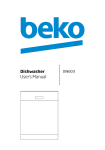





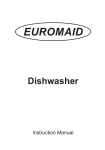
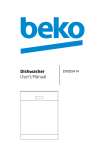








![12 place dishwasher 5 prog [ddw 175]](http://vs1.manualzilla.com/store/data/005678375_1-ad0b6eb6321fc485c4ee202ebc6e276f-150x150.png)
